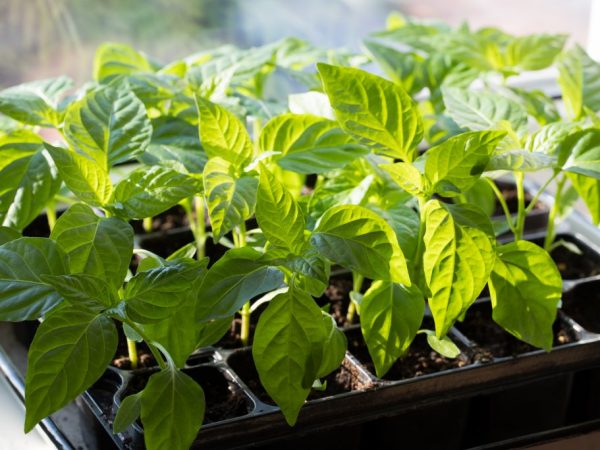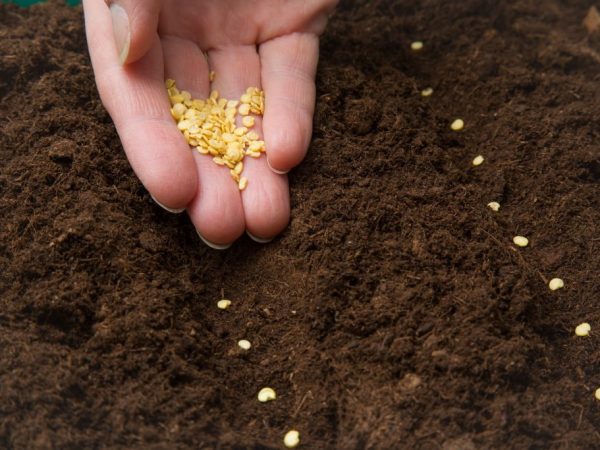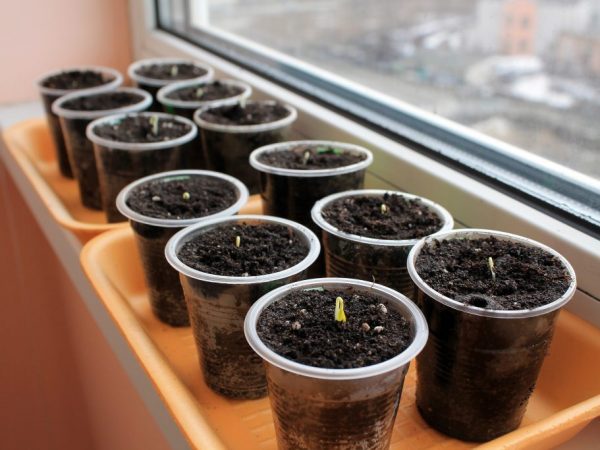Growing pepper on a windowsill
Some people who live in apartments also want to have their own small garden. Growing pepper on a windowsill is a good alternative to country cultivation.

Growing pepper on a windowsill
Selection of seeds, soil and capacity
Seed selection
First you need to decide on a vegetable variety that is suitable for growing in window conditions. The main differences between the different varieties are the taste and size of the fruit. They are usually divided into 2 categories: sweet and savory. But they also take into account the ripening time.
The best varieties of sweet Bulgarian vegetables are:
- Salute;
- Treasure Island;
- Dwarf;
- Golden baby;
- Watercolor;
- Etude;
- Carat.
If you want to plant a bitter or spicy look, you should pay attention to the following varieties:
- Falcon's Beak;
- Bell;
- Bishop's Crown;
- Coral;
- Fiery Virgo.
It is necessary to assess the quality of the seed. For this, the purchased seeds are placed in warm water for 5-10 minutes. Those that come up are of poor quality and empty, they need to be thrown out. If the seeds remain at the bottom of the container, they can be used for planting.
Soil selection
The vegetable on the windowsill grows well in a special soil mixture. But making soil for a vegetable crop yourself is also not difficult. The following components are mixed:
- 2 parts of sod land;
- 1 part sand;
- 1 part of humus;
- 1 part peat.
Another option for a seedling mixture is to mix 1 part sawdust, 1 part sand and 3 parts turf soil. Sawdust, if desired, can be replaced with peat.
The acidity of the soil should not exceed 5-7 pH. You cannot add clay to the created soil.
If the soil is purchased, it is imperative to study its composition. If it is 100% peat, then the probability that a large and healthy crop will grow in it is low.
Choice of capacity
A regular plastic container is suitable for growing pepper seedlings. The optimal size is 20 * 15-20 cm. In such a container it will be possible to place up to 30-40 seeds.
For picking, peat pots are taken, into which each sprout is transplanted. Such containers do not block air exchange, retain moisture and are well suited for windows.
Peat pots are later replaced by wooden boxes or plastic containers. They are selected in accordance with the size of the plant and its root system. Instead of plastic pots, you can take ceramic ones. It is important that there are holes in the bottom. They are needed to drain excess fluid.
Treatment

Seeds must be disinfected before planting.
After preparing pepper seeds, soil and containers, they are disinfected. A manganese solution is perfect for this. Recipe:
- take 5 g of manganese;
- dilute in 10 liters of warm water;
- let it brew for 1-2 hours.
If seeds are processed, then they are placed inside the solution for 15-20 minutes. Then they are washed with warm water and dried.
If it is necessary to process the soil, then it is simply watered with a manganese solution. Consumption - 5 liters of mortar per 1 m2 (about 10 medium pots).A day after treatment, the soil must be loosened to remove the soil crust and give access to oxygen.
You can disinfect the container simply by pouring boiling water over it. If desired, the walls of the pot or container are wiped with alcohol.
Growing conditions
When growing peppers on a windowsill, you need to adhere to the same conditions as when planting a vegetable in open ground. They select lighting, temperature conditions and observe the level of humidity.
You cannot put sweet, bitter, spicy varieties on one window. After the pollination process, their flavors will mix, especially in sweet varieties that will have a bitter taste.
Lighting
This variety of pepper loves to be exposed to the sun's rays, but in small quantities. Therefore, from time to time it must be removed in the shade so that the leaves do not dry up or the seedlings do not start to stretch out before ripening.
Lighting requirements:
- Pepper seedlings are best placed on the south or east window.
- On especially sunny and hot days, transfer to a cool, shaded place in the house (corridor, balcony, room in the western part of the house).
- Lack of light negatively affects the condition of peppers, especially sweet peppers. If the cultivation takes place in winter, it is necessary to use additional light sources - phytolamps or any other lamps. Remember, daylight hours when growing pepper on a windowsill is 10-12 hours.
Temperature regime
Vegetables almost always need warmth. The plant can withstand temperatures up to 12 ° C, but it grows best in a temperature climate of 24-27 ° C.
Pepper seedlings cannot be in a draft. Otherwise, it will quickly die or give a poor harvest.
Do not make sudden changes in temperature. The pepper on the windowsill reacts poorly to them and can fade.
Humidity level
A vegetable loves moisture, so it is good to grow it in a kitchen where the moisture level is high. If necessary, you can transfer the seedlings for several hours to the bathroom or basement.
Landing

Seedlings need sunlight
Planting of pepper occurs at the end of February or at the beginning of March. You need to focus on the weather and what it will be according to the forecast in a week.
Landing is carried out according to the following rules:
- up to 3 pepper seeds can be placed in 1 hole;
- the distance between the holes is at least 3 cm;
- planting depth - 2 cm.
The planting pot is placed on a windowsill near a radiator or other warm place. For a quick emergence of seedlings, it can be watered and covered with a plastic bag to create a greenhouse effect. And after 5-7 days, put on a window in the sunny side.
Pepper care
All care procedures must be done in a timely manner. Only then can you expect an excellent harvest.
Watering
This vegetable crop must be watered with settled, warm water (minimum temperature - 34 ° C). In winter and spring, root watering is carried out 2 times a week, and once every 1.5-2 weeks - spraying the entire bush, wiping the leaves with soapy water to prevent diseases.
In the summer, when the room temperature exceeds 28 ° C, the peppers on the windowsill need to be watered daily. Spraying the whole plant is also carried out every day, sometimes 2 times.
If a pepper bush stands near a battery in winter, cover it with a damp cloth. This will help maintain normal moisture levels and keep the plant from overheating.
Topping
The bushes of lettuce bell pepper require a garter after their height reaches 15-20 cm. Pinch the crown so that the plant does not bend, does not stretch, does not bloom ahead of time. Another goal of this procedure is to improve the branching so that as many fruits as possible are produced.
Top dressing
The purpose of feeding is to enrich the vegetable crop with vitamins, to eliminate the deficiency of minerals. Good quality livestock stimulates growth.
Top dressing is carried out every 15 days and only after watering. This is necessary so as not to burn the roots.
The first feeding is carried out when planting in the ground.Add 150 g of lime per 10 kg. Also add 2 cups of wood ash. The components do not need to be mixed with water; they are immediately added to the soil mixture. Such feeding is needed to increase the plant's resistance to pests, improve the quality of the soil.
Other options for feeding peppers:
- The second feeding is carried out after the formation of 2-3 true leaves. For her, take 5 g of urea, 50 g of superphosphate and 10 g of potassium salt. Dissolve in 5 liters of warm, boiled water. This is enough to feed 5-7 adult pepper bushes.
- The third prying is carried out on the basis of organic components after fruit setting. It will take 2 tbsp. tablespoons of ash, 2 g of urea. They are bred in 1 liter of water.
- The fourth feeding is done on the basis of decoctions. Occurs 14 days before harvest. Use decoctions of clover, chamomile, nettle, plantain.
Loosening the soil
Even if the vegetable is grown at home, loosening is carried out. It is needed to remove the soil crust that appears the next day after watering.
Loosening stimulates the growth of bushes. In the process, it is important not to hurt the root system.
Pests and diseases
Excessive and abundant watering, poor soil quality, ignoring seed disinfection are the main reasons why a plant is affected by pests or diseases.
The main pests of the vegetable:
| Pest name | Signs | Control methods |
| Aphid | White insects that appear on the inside of the leaves. It feeds on plant sap. Reproduces in colonies. Appears if there are ants at home. | Chemicals help - Keltan and Karbofos. Take 1 teaspoon of each product and dilute in 1 liter of water. Let it brew for 3 hours, after which it is brought under the root. |
| Spider mite | Bulgarian pepper affects. The main feature is the cobweb on the underside of the leaves. Soon, dark, brown spots appear throughout the plant. | The bush is treated with a chlorine solution. This will require 1 kg of bleach. Mix with 5 liters of water until a mixture is formed, which is equal in consistency to thick sour cream. For irrigation, dilute with another 10 liters of water. |
| Whitefly | Often appears due to moths in the house. It develops actively if the room is very hot and dry. After its exposure, white spots and shiny mucus appear on the leaves. | The treatment is carried out with Intavir. The chemical does not harm the fruit. You need to dissolve 1 tablet in warm water. Consumption - 0.5 liters of solution for 1 bush. |
Conclusion
It is quite possible to grow peppers at home. First, they choose seeds, soil and containers, which are carefully processed after purchase. In order for the pepper to give a lot of high-quality harvest, it is watered 2 times a week, loosened, pinched, and fertilized.


